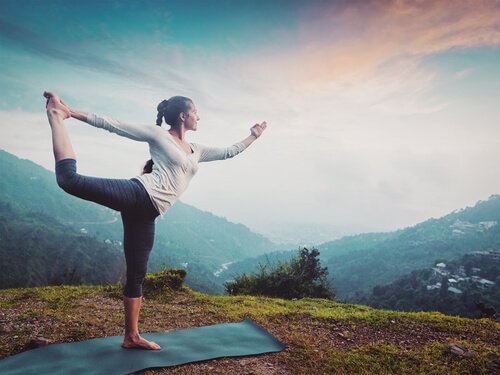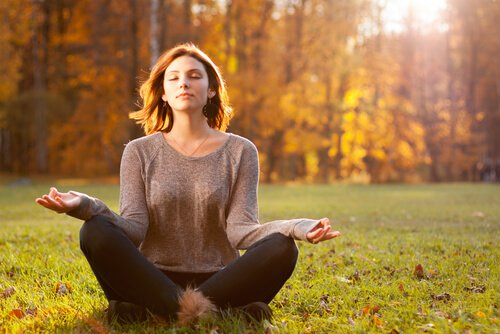Learning to Live in your own Body

80% of the fibers in the vagus nerve connecting the brain to many of our internal organs are afferent. In other words, those fibers run along the external part of our bodies up to our brains. This means we can train and directly control our activation system through breathing and movement.
This way of training the body has been fundamental for ages in China and India. The study of Eastern and alternative medicine has found ways to improve your state of being in a more natural way. Unfortunately our culture as a whole is still skeptical.
Working on your body to find yourself
We all know how to breathe. But learning to calm and slow down your breathing is another matter. It’s also important for many people in regaining their mental health. When you consciously take deep, slow breaths, you’re telling your body to pause its PNS (parasympathetic nervous system).

For example, when you’re working through the effects of trauma and abandonment, emotional regulation can make a big difference in the results. One aspect is respiratory control. The more focused you are on your breathing, the more benefits you’ll get.
It’s important to pay attention to the beginning and end of a breath. Once one is over, wait a moment before you start another. If you notice the air coming and going from your body you will understand this “vital, natural action”.
Harmonizing body and mind through yoga
Yoga is a traditional discipline from India. It means “a union of physical and mental well-being.” The word also has a link to meditation practices in Hinduism, Buddhism, and Jainism. Some types of yoga can help you connect to the deepest, most forgotten parts of yourself. Yoga is more than just a form of exercise, or a relaxation technique. Here are the main benefits:
- Developing your consciousness. It also helps you become aware of your potential and your natural abilities, along with your resistances and your fears.
- Internal peace. Thanks to its calming effect, it helps you go through life in a tranquil, confident way.
- Improving your ability to be present in your own life. It relieves pain, reduces stress, improves breathing…
- Improving your health. There’s a long list of all the health benefits yoga has. For example, it’s great for cardiovascular training, weight management, breathing, flexibility, etc…
A study by the National Institute of Health (NIH), showed that ten weeks of practicing yoga reduced symptoms related to PTSD (post-traumatic stress disorder). The patients who responded best hadn’t had success with other kinds of treatment.
“When you listen to your own body respectfully and sensitively, when you learn to objectively observe your own mind, and when you learn to accept the reality of your internal world, that’s when you get the most benefits out of yoga.”

Types of movement that can improve your health
Some cultures in Japan and Korea focus on increasing your awareness of movement, and the present moment. These are skills that people with trauma tend to have issues with. Martial arts like aikido, judo, taekwondo, jujitsu, and capoeira (from Brazil) can help. They have things in common like physical movement, breathing, and meditation.
Yoga, taichi, gigong in China, or rhythmic drumming from Africa also support the idea that you can get better through self-knowledge.. Jon Kabat-Zinn is one of the pioneers in treatment that tries to improve the communication lines between body and mind. In 1979, he started the Stress-Reduction Clinic, with the goal of helping people increase their self-awareness.
“If you stop trying to make yourself more than you are, out of fear that you are less than you are, whoever you really are will be a lot lighter and happier and easier to live with, too.”
-Jon Kabat-Zinn
Paying attention to your bodily sensations can help you recognize the highs and lows of your emotions. Once you’ve recognized them, it will be easier for you to control them. Practicing self-awareness calms your sympathetic nervous system. It also reduces the chances of a fight or flight response. This means that bodily awareness helps you let out feelings or impulses that are blocked.

Your sensory world comes about before you do
You can’t fully heal if you don’t feel secure in your own skin. Getting your physical tension out will help get your feelings out too. Movement helps you breathe more deeply, and get those tensions to leave your body. This works for abused children, soldiers with PTSD, victims of sexual abuse, refugees, etc. All their stories are a testament to how effective expressive therapies can be.
Support for new therapeutic treatment only comes for things that have already been proven. Almost four decades passed between the discovery of penicillin’s antibiotic properties in 1928 (by Alexander Fleming), and our full understanding of how it worked, in 1965.
80% of the fibers in the vagus nerve connecting the brain to many of our internal organs are afferent. In other words, those fibers run along the external part of our bodies up to our brains. This means we can train and directly control our activation system through breathing and movement.
This way of training the body has been fundamental for ages in China and India. The study of Eastern and alternative medicine has found ways to improve your state of being in a more natural way. Unfortunately our culture as a whole is still skeptical.
Working on your body to find yourself
We all know how to breathe. But learning to calm and slow down your breathing is another matter. It’s also important for many people in regaining their mental health. When you consciously take deep, slow breaths, you’re telling your body to pause its PNS (parasympathetic nervous system).

For example, when you’re working through the effects of trauma and abandonment, emotional regulation can make a big difference in the results. One aspect is respiratory control. The more focused you are on your breathing, the more benefits you’ll get.
It’s important to pay attention to the beginning and end of a breath. Once one is over, wait a moment before you start another. If you notice the air coming and going from your body you will understand this “vital, natural action”.
Harmonizing body and mind through yoga
Yoga is a traditional discipline from India. It means “a union of physical and mental well-being.” The word also has a link to meditation practices in Hinduism, Buddhism, and Jainism. Some types of yoga can help you connect to the deepest, most forgotten parts of yourself. Yoga is more than just a form of exercise, or a relaxation technique. Here are the main benefits:
- Developing your consciousness. It also helps you become aware of your potential and your natural abilities, along with your resistances and your fears.
- Internal peace. Thanks to its calming effect, it helps you go through life in a tranquil, confident way.
- Improving your ability to be present in your own life. It relieves pain, reduces stress, improves breathing…
- Improving your health. There’s a long list of all the health benefits yoga has. For example, it’s great for cardiovascular training, weight management, breathing, flexibility, etc…
A study by the National Institute of Health (NIH), showed that ten weeks of practicing yoga reduced symptoms related to PTSD (post-traumatic stress disorder). The patients who responded best hadn’t had success with other kinds of treatment.
“When you listen to your own body respectfully and sensitively, when you learn to objectively observe your own mind, and when you learn to accept the reality of your internal world, that’s when you get the most benefits out of yoga.”

Types of movement that can improve your health
Some cultures in Japan and Korea focus on increasing your awareness of movement, and the present moment. These are skills that people with trauma tend to have issues with. Martial arts like aikido, judo, taekwondo, jujitsu, and capoeira (from Brazil) can help. They have things in common like physical movement, breathing, and meditation.
Yoga, taichi, gigong in China, or rhythmic drumming from Africa also support the idea that you can get better through self-knowledge.. Jon Kabat-Zinn is one of the pioneers in treatment that tries to improve the communication lines between body and mind. In 1979, he started the Stress-Reduction Clinic, with the goal of helping people increase their self-awareness.
“If you stop trying to make yourself more than you are, out of fear that you are less than you are, whoever you really are will be a lot lighter and happier and easier to live with, too.”
-Jon Kabat-Zinn
Paying attention to your bodily sensations can help you recognize the highs and lows of your emotions. Once you’ve recognized them, it will be easier for you to control them. Practicing self-awareness calms your sympathetic nervous system. It also reduces the chances of a fight or flight response. This means that bodily awareness helps you let out feelings or impulses that are blocked.

Your sensory world comes about before you do
You can’t fully heal if you don’t feel secure in your own skin. Getting your physical tension out will help get your feelings out too. Movement helps you breathe more deeply, and get those tensions to leave your body. This works for abused children, soldiers with PTSD, victims of sexual abuse, refugees, etc. All their stories are a testament to how effective expressive therapies can be.
Support for new therapeutic treatment only comes for things that have already been proven. Almost four decades passed between the discovery of penicillin’s antibiotic properties in 1928 (by Alexander Fleming), and our full understanding of how it worked, in 1965.
All cited sources were thoroughly reviewed by our team to ensure their quality, reliability, currency, and validity. The bibliography of this article was considered reliable and of academic or scientific accuracy.
Cowen, V. S., & Adams, T. B. (2005). Physical and perceptual benefits of yoga asana practice: Results of a pilot study. Journal of Bodywork and Movement Therapies. https://doi.org/10.1016/j.jbmt.2004.08.001
This text is provided for informational purposes only and does not replace consultation with a professional. If in doubt, consult your specialist.







